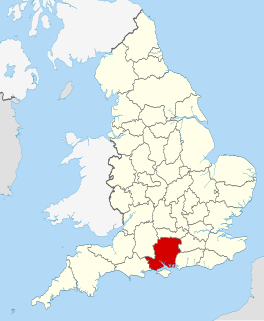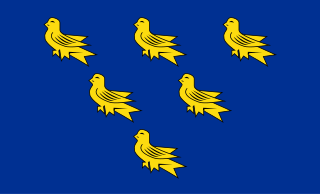| South Coast Plain | |
|---|---|
| Region | |
 River Hamble | |
| Coordinates: 50°50′N0°40′W / 50.833°N 0.667°W Coordinates: 50°50′N0°40′W / 50.833°N 0.667°W | |
| Country | England |
| Region | Hampshire, Sussex |
| Area | |
| • Total | 522.45 km2 (201.72 sq mi) |
| Population (2001) | |
| • Total | 505,822 [1] |
The South Coast Plain is a natural region in England running along the central south coast in the counties of East and West Sussex and Hampshire.

East Sussex is a county in South East England. It is bordered by the counties of Kent to the north and east, Surrey to the north west and West Sussex to the west, and to the south by the English Channel.

West Sussex is a county in the south of England, bordering East Sussex to the east, Hampshire to the west and Surrey to the north, and to the south the English Channel.

Hampshire is a county on the southern coast of England. The county town, with city status, is Winchester, a frequent seat of the Royal Court before any fixed capital, in late Anglo-Saxon England. After the metropolitan counties and Greater London, Hampshire is the most populous ceremonial county in the United Kingdom. Its two largest settlements, Southampton and Portsmouth, are administered separately as unitary authorities and the rest of the area forms the administrative county, which is governed by Hampshire County Council.
It has been designated as National Character Area No. 126 by Natural England. The NCA has a total area of 52,245 hectares and forms a coastal strip, 2 to 16 kilometres wide, running from the area of Hamble-le-Rice in Hampshire in the west across the entire length of West Sussex to Brighton in East Sussex to the east. [1]
A National Character Area (NCA) is a natural subdivision of England based on a combination of landscape, biodiversity, geodiversity and economic activity. There are 159 National Character Areas and they follow natural, rather than administrative, boundaries. They are defined by Natural England, the UK government's advisors on the natural environment.
Natural England is a non-departmental public body in the United Kingdom sponsored by the Department for Environment, Food and Rural Affairs. It is responsible for ensuring that England's natural environment, including its land, flora and fauna, freshwater and marine environments, geology and soils, are protected and improved. It also has a responsibility to help people enjoy, understand and access the natural environment.

Hamble-le-Rice is a village and civil parish in the Borough of Eastleigh in Hampshire, UK. It is best known for being an aircraft training centre during the Second World War and is a popular yachting location. The village and the River Hamble also featured in the 1980s BBC television series Howards' Way. The village centre, known as The Square, Hamble, has a more traditional English village aesthetic which differentiates it from the small industrial areas close-by the village.
Its major settlements include the cities of Brighton and Hove, Chichester and Portsmouth, the market town of Fareham, the coastal town of Gosport and the seaside resorts of Bognor Regis, Littlehampton and Worthing. It is bordered by the New Forest across Southampton Water to the west, the South Hampshire Lowlands to the northwest, the South Downs to the north and east, and the Isle of Wight across the Solent to the southwest. [1]

Brighton and Hove is a seaside city in East Sussex, in South East England. The towns of Brighton and Hove formed a unitary authority in 1997 and in 2001 were granted city status by Queen Elizabeth II. "Brighton" is often referred to synonymously with the official "Brighton and Hove" although many locals still consider the two to be separate towns. At the 2011 census, the city was England's most populous seaside resort, with a population of 273,400.

Chichester is a cathedral city in West Sussex, in South-East England. It is the only city in West Sussex and is its county town. It has a long history as a settlement from Roman times and was important in Anglo-Saxon times. It is the seat of the Church of England Diocese of Chichester, with a 12th-century cathedral.

Portsmouth is a port city in Hampshire, England, with a total population of 205,400 residents. The city of Portsmouth is nicknamed Pompey and is mainly built on Portsea Island, a flat, low-lying island measuring 24 square kilometres in area, just off the south-east coast of Hampshire. Uniquely, Portsmouth is the only island city in the United Kingdom, and is the only city whose population density exceeds that of London.















